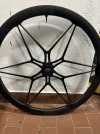Energy is primarily supplied from two sources:
Carbohydrates - in the form of glycogen stored in the muscles
Fat - stored around the body
During exercise, we use a combination of these energy sources. At a high intensity the main source of energy is carbohydrate and at a low intensity fat is the predominate source. As there is a limit to the amount of carbohydrate that can be stored in the muscles, high intensity work can only be sustained for short periods. We have large stores of fat so low intensity work can be maintained for long periods.
Intensity and Energy Source
The following table, adapted from O'Neil (2001) [1], shows the relationship between exercise intensity (% of your Maximum Heart Rate) and the energy source (carbohydrate and fat).
Intensity % MHR / % Carbohydrate / % Fat
65 to 70 / 40 / 60
70 to 75 / 50 / 50
75 to 80 / 65 / 35
80 to 85 / 80 / 20
85 to 90 / 90 / 10
90 to 95 / 95 / 5
100 / 100 / 0
Respiratory Exchange Ratio (RER)
Carbohydrates, fat and protein all play a part in energy metabolism and for a certain volume of oxygen the energy released will depend upon the energy source. It is possible to estimate which particular fuel (carbohydrate, fat or protein) is being oxidised by calculating the Respiratory Exchange Ratio (RER). RER is the ratio of carbon dioxide (CO2) produced to oxygen (O2) consumed and is known as the Respiratory Quotient (RQ).
If carbohydrate is completely oxidised to CO2 and water (H2O) then the relationships is as follows:
6O2+ C6H12O6 » 6CO2 + 6H2O + 38ATP (Adenosine Triphosphate)
RER = 6CO2 ÷ 6O2 = 1
If fat is completely oxidised to CO 2 and H2O then the relationships is as follows:
C16H32O2 + 23O2 » 16CO2 + 16H2O + 129ATP
RER = 16CO2 ÷ 23O2 = 0.7
The RER for protein is approx. 0.8 but as it plays a very small part in energy metabolism, it is not important here. A value between 0.7 and 1.0 indicates a mixture of fat and carbohydrate as the energy source. A value greater than 1.0 indicates anaerobic respiration due to more CO2 being produced than O2 consumed.
Referenced Material
O'NEIL, T. et al. (2001) Indoor Rowing Training Guide. Concept 2 Ltd, p. 27
Page Reference
The reference for this page is:
MACKENZIE, B. (2001) Exercise Intensity and Energy Source [WWW] Available from: http://www.brianmac.co.uk/esource.htm [Accessed 9/9/2011]
Carbohydrates - in the form of glycogen stored in the muscles
Fat - stored around the body
During exercise, we use a combination of these energy sources. At a high intensity the main source of energy is carbohydrate and at a low intensity fat is the predominate source. As there is a limit to the amount of carbohydrate that can be stored in the muscles, high intensity work can only be sustained for short periods. We have large stores of fat so low intensity work can be maintained for long periods.
Intensity and Energy Source
The following table, adapted from O'Neil (2001) [1], shows the relationship between exercise intensity (% of your Maximum Heart Rate) and the energy source (carbohydrate and fat).
Intensity % MHR / % Carbohydrate / % Fat
65 to 70 / 40 / 60
70 to 75 / 50 / 50
75 to 80 / 65 / 35
80 to 85 / 80 / 20
85 to 90 / 90 / 10
90 to 95 / 95 / 5
100 / 100 / 0
Respiratory Exchange Ratio (RER)
Carbohydrates, fat and protein all play a part in energy metabolism and for a certain volume of oxygen the energy released will depend upon the energy source. It is possible to estimate which particular fuel (carbohydrate, fat or protein) is being oxidised by calculating the Respiratory Exchange Ratio (RER). RER is the ratio of carbon dioxide (CO2) produced to oxygen (O2) consumed and is known as the Respiratory Quotient (RQ).
If carbohydrate is completely oxidised to CO2 and water (H2O) then the relationships is as follows:
6O2+ C6H12O6 » 6CO2 + 6H2O + 38ATP (Adenosine Triphosphate)
RER = 6CO2 ÷ 6O2 = 1
If fat is completely oxidised to CO 2 and H2O then the relationships is as follows:
C16H32O2 + 23O2 » 16CO2 + 16H2O + 129ATP
RER = 16CO2 ÷ 23O2 = 0.7
The RER for protein is approx. 0.8 but as it plays a very small part in energy metabolism, it is not important here. A value between 0.7 and 1.0 indicates a mixture of fat and carbohydrate as the energy source. A value greater than 1.0 indicates anaerobic respiration due to more CO2 being produced than O2 consumed.
Referenced Material
O'NEIL, T. et al. (2001) Indoor Rowing Training Guide. Concept 2 Ltd, p. 27
Page Reference
The reference for this page is:
MACKENZIE, B. (2001) Exercise Intensity and Energy Source [WWW] Available from: http://www.brianmac.co.uk/esource.htm [Accessed 9/9/2011]
Ultima modifica:

